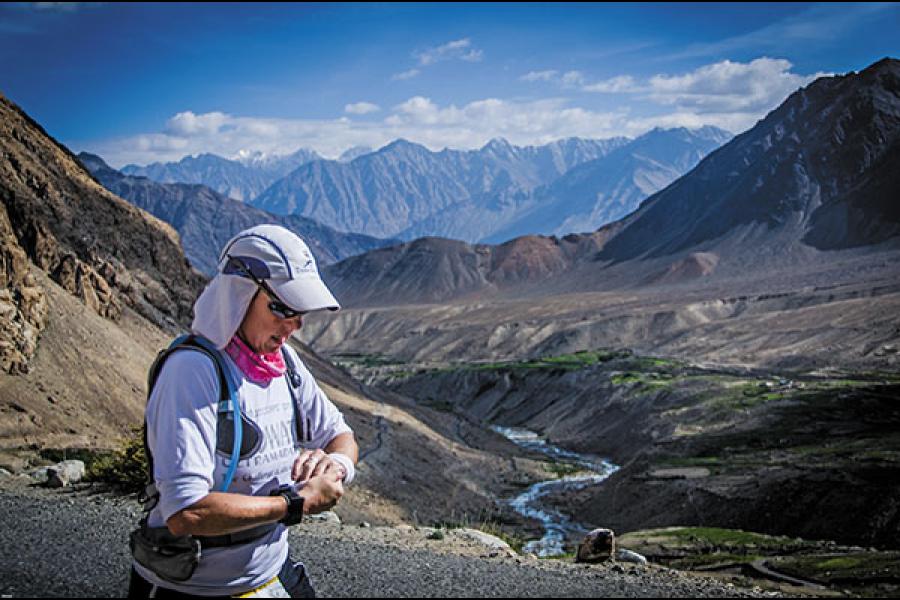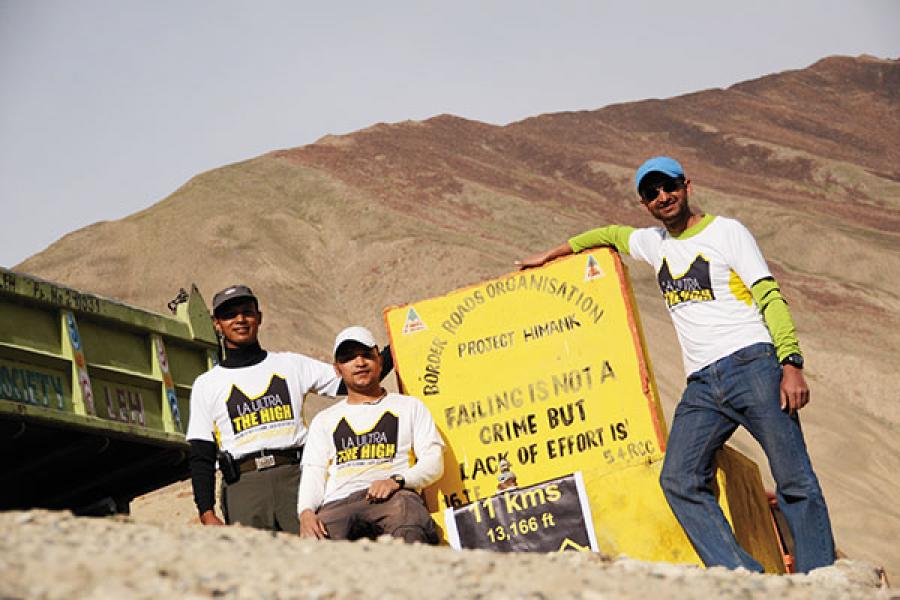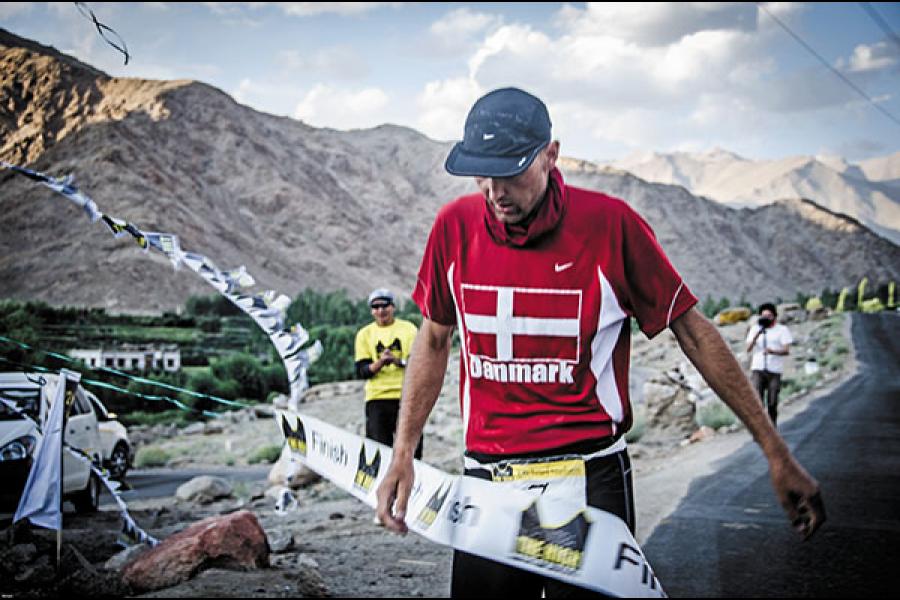
Why 'La Ultra - The High' is the Cruelest Marathon
La Ultra-The High, the cruellest run in the world, is as much a test of the mind as it is of the body
I’m a medical doctor. And there’s one thing I know for a fact. When you’re born, the only thing you can be certain of is that you’ll die. So if you want to live safe, you might as well wear a helmet and wait it out until death claims you. Call me crazy. But if you are not running or living on the edge, you’re wasting space!
I think that is why I thought up the La Ultra or The High. This is the cruellest run in the world. Imagine running 222 kilometres on foot through Leh and Ladakh, the highest altitude deserts anywhere within 60 hours where temperatures can drop to as low as minus 10 degrees Celsius and go up to 40 degrees on the other extreme.
What makes it worse is that at those altitudes, the oxygen available to breathe is just 40 percent of what is available at sea level. To put that into perspective, imagine running with your nostrils shut for at least two consecutive days and nights.
When we pitched the idea to the Adventure Wing at the Army Headquarters, they first rejected the idea as not do-able. We insisted and came up with options. They laughed at us and said “civilians can't do it”. That was the motivation we needed. If it was any easier, why bother!
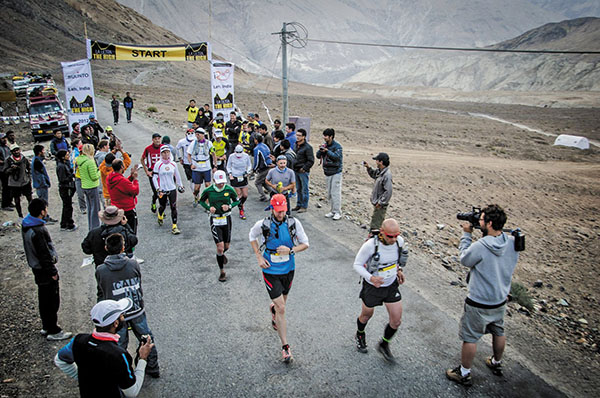
The start of La Ultra 2012 was between Khalsar village and Khardung village
Most participants at the La Ultra have participated in the Badwater Ultra, often described as the world’s toughest foot race. It starts off below sea level (282.15 feet) at the Badwater Basin in California’s Death Valley and ends at Whitney Portal, at an elevation of 8,064.3 foot. Temperatures there are in the region of 50 degrees Celsius.
During the first edition of the La Ultra in 2010, two of the three participants dropped out. Only Mark Cockbain from the UK managed to cross the finish line. On the way though, he experienced hypothermia and could have wavered off the edge. If he hadn’t completed, everybody who thought it impossible would have been proven right.
So why would anybody want to do something as insane? Various reasons. Let me begin from the beginning. The La Ultra was thought up in October 2009 when I’d gone on a running trip with a buddy from Manali to Rohtang Pass. We did it simply because we loved to run and wanted to push ourselves to the limits on routes motorcyclists think of as their Mecca.
Before that, I had attempted to run five marathons in five days, from Jodhpur to Jaisalmer in temperatures that ran in excess of 40 degrees Celsius. I managed to complete four.
Often times I remembered the retinal detachment I had in 1993, when I was asked to give up running. I picked up ultra running after that. I can still see and my eyes continue to reside where they ought to. The point I’m trying to make is, anybody can do it, so long as you have the will to do it.
That’s the thing about the human body. You won’t know how far you can push it until you try. For instance, when running through Rajasthan, I was hallucinating. I could see dancing girls around me where there was nothing but miles of desert. But you put your head down and tell yourself, I’m not quitting today.
You have to keep playing games with yourself in the mind. When I ran from Paris to London, I started off telling myself I need to get to the finish. But like every runner knows, once the pain starts to kick in, things change.
You being to break things in your head into smaller units. For instance, from wanting to finish, you tell yourself to push for another 21 kilometres. When that gets tough, you beg and tell yourself to do just 10 more. As the pain becomes unbearable, you tell yourself, just one more kilometre. Then it comes down to doing just one more step. You keep playing these little games in your head with yourself.
While I hate targets, I set them because it helps me do a little more. I also know these targets will keep moving. And as you run longer, you learn to think not on your feet, but with your feet. I try not to think of a plan as well. Because as Mike Tyson once said about plans, “Everybody has a plan until they get punched in the face”.
For instance, during last year’s event, 15 hours into the run, we found water levels in rivers getting higher and threatening to flood the roads. We decided to change the route then and there. To do that, everybody needs to be nuts because this is something everybody’s prepared at least 8-9 months for and during the event, the course changes.
As luck would have it, during all three editions of the La Ultra, the second evening into the run we’ve faced white outs, courtesy blizzards. By then, if the participants haven't finished, they’re completely exhausted and have blistered feet. Most rest then and carry on the next morning.
In the third edition, Dr William (Bill) Andrews, refused to stop and kept going. When he was five kilometres short of the second mountain pass, wind speeds picked up and the blizzard took temperatures tumbling to minus 10 degrees. His crew forced him to wait it out, until a documentary crew caught up with him and wanted a running shot. Bill got out and continued until the top. Since then, he’s known as the Blizzard Man.
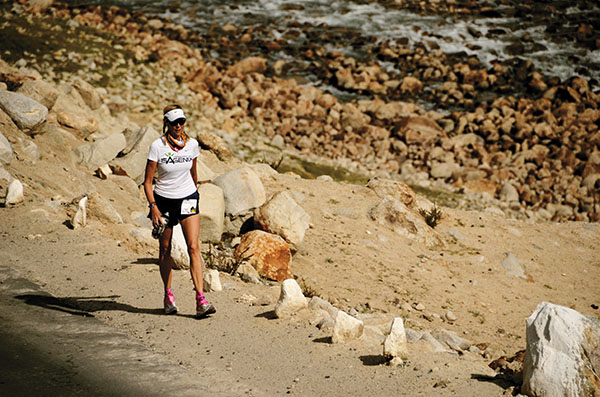
Molly Sheridan, from the US, came back in 2011 to fi nish what she started in 2010
During the 2011 edition, at our camp 14,000 feet above sea level, there was a sand storm that shook the confidence levels of some of the world’s best ultra runners. The wind came with such force that even SUVs parked there started to move sideways.
The biggest challenge at these heights is High Altitude Sickness (HAS), which can be fatal. It is unpredictable and can hit even the fittest athletes. Over the last three editions, two crew members and two participants developed HAS, three of them even before the run started.
The only way to address this is to acclimatise to high altitude by being in Leh at least 11 days before the start of the run. This makes the event a 15 day expedition. To add to that, each participant needs a team of three to four crew members and a vehicle at their disposal at all times. That makes it an expensive affair.
When I first started to look for crew members to accompany runners during the first edition, I wanted people who were both adventurous and humble. When they first volunteered, I started by offering a million reasons why they ought not to try it. If they persisted, I interviewed them to assess their attitude. If I thought they fit the profile I was looking for, I told them they’d have to pay me because I was bankrupt.
I managed to get 11 crew-members from Delhi, Bangalore, Mumbai and Pune. One actually joined us by hitching a ride on a ship, first to Greece, then to Spain and finally to India, because he wanted to be part of it, but couldn’t otherwise afford it. Over the three editions that we have so far done, folks from all over India, Germany, France, the US, the UK, Australia, New Zealand, Hong Kong, Singapore and Philippines have come to participate as crew members. For the 2013 edition, some people are driving down from London to Leh.
The role of crew members at La Ultra is similar to that of a domestique in the Le Tour de France, or the pit crew in Formula 1 racing. Domestique literally means servant. They work their hearts out to help participants finish at the top. But they remain anonymous. How many of us know the names of even one person who was part of Michael Schumacher’s team? Even a delay by a fraction of a second by any of them could have cost him his championship.
For anybody interested in crewing for the La Ultra, they need to be nuts as well. If they try to make too much sense of the whole thing, it simply leads to ‘paralysis by analysis’. Besides, they need to be selfless team players. They ought to respect nature and the people they’re working with. These mountains only respect people who offer them respect.
There was this one instance before the 2011 edition when one of the crew members from Delhi nick named me Dr Death after I kept warning him how dangerous the whole thing is. When he landed in Leh to crew, he continued being reckless and ignored advice. I told him if he continued like that, he’d have to be carried back home in a body bag. He didn’t respond. But two days later, he quit at the 60 kilometre mark and left his runner stranded.
Aparna Choudhary, a lady who replaced him, managed for the next 160 kilometres. In July 2013, she will be the first Indian to take part in this run. I am so betting on Aparna on finishing this run and prove what I believe in: Anybody is capable of participating in this insane event.
To even remotely think about achieving this next-to-impossible task, you ought to respect everybody and everything around. Anything less and death is inevitable. But evolution has primed humans for endurance events. That said, frankly, La Ultra is a run for challenge-seekers who find other extreme runs too tame.
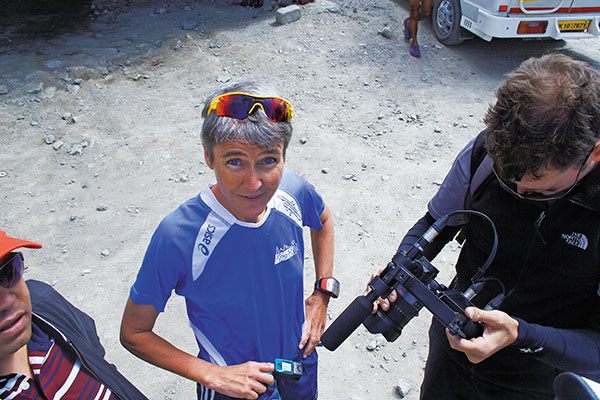
Sharon Gayter, an asthmatic from the UK, came first in the 2011 edition, in 37 hr 34 min 37 sec
Sharon Gayter, a 47-year-old woman from UK, an asthmatic, finished running the entire distance, in 38 hours and won the second edition. Kim Rasmussen, a Dane who participated last year was going strong, but met with an accident 100 kilometres into the run. A biker hit him head on. Kim hurt his head, both his hands and knees. Anyone else would have quit right there. Kim finished the run in 46 hours and 25 minutes. Mention any of this to top medical specialists, and their eyes will pop.
There have been many requests to make the event easier to attract people who aren’t as accomplished as the runners who now participate in it. So beginning this year, we’ve introduced a shorter variant called the ‘Eleventy-One’. Traversing 111 kilometres, it can teach you more about life and business than any masters degree in business administration can. The cut-off time for this run is 24 hours.
You need to be crazy to participate, but sensibly so.
Dr Rajat Chauhan founded the La Ultra (thehigh.in). In his day job, he is Founder & Medical Director at Back 2 Fitness (www.b2f.in), a sports medicine and musculoskeletal rehabilitation centre.
(This story appears in the 22 February, 2013 issue of Forbes India. To visit our Archives, click here.)
-
 Karar Hussain
Karar Hussainplz get me marathon Info.. and your mo nomber..
on Apr 17, 2014 -
 Dr Suhail Ahmed Khan
Dr Suhail Ahmed KhanReally applaudable. Hats off to these unsung heroes. This enthusiasm , zeal , and zest has nothing to do with a normal being. Only those extraordinary people can indulge in such activities who have immense love for nature and who want to mingle with it. It can be take up to check your physical strength and stamina besides experiencing the love and cruelty of nature at the same time. I salute these personalities
on Apr 6, 2013 -
 Sachi Mohanty
Sachi MohantyThese guys must be spending like four hours daily in exercising ... keeping themselves fit? I don\'t know .... Where do they find time to do the other stuff? Making a living is one thing. Apart from that, there is the business of keeping oneself in the loop, right? Like reading Forbes ... @sachi_bbsr
on Feb 18, 2013
